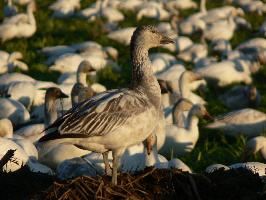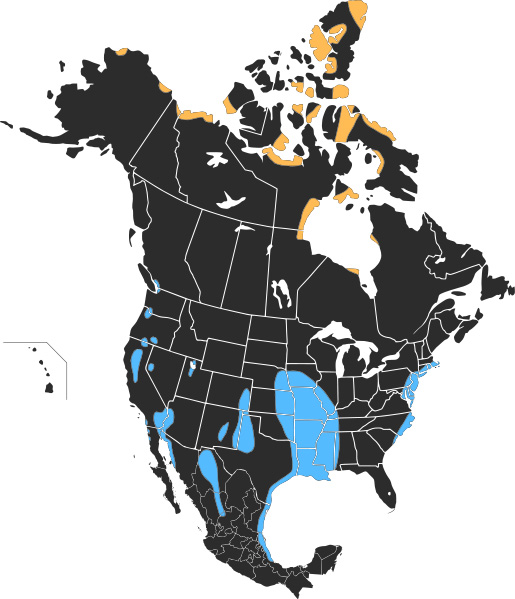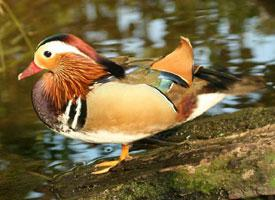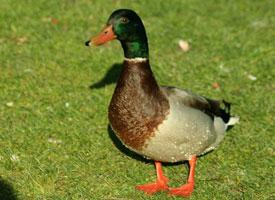
Poids et mesures
| Hauteur au garrot | de 65 à 75 cm |
|---|---|
| Poids | de 2,4 à 3,4 kg |
Description de l'animal
The Snow Goose, scientifically named Anser caerulescens, is a captivating bird species belonging to the family Anatidae, which includes ducks, geese, and swans. This species is renowned for its striking plumage, migratory habits, and the impressive formations it creates during flight. Snow Geese are highly social creatures, often found in large, noisy flocks. They play a significant role in their ecosystems, influencing the habitats they pass through during their migratory journeys.Physical Characteristics:
Snow Geese are medium-sized birds, typically measuring between 25 to 31 inches in length, with a wingspan ranging from 54 to 66 inches. They exhibit sexual dimorphism, with males generally larger than females. One of the most distinguishing features of the Snow Goose is its plumage. They are primarily recognized in their white phase, where they display an immaculate white body contrasted with black wingtips. However, there's also a "blue" morph, where the bird sports a dark bluish-grey body and a white head, creating a striking visual contrast. Juveniles of the blue morph are darker overall, lacking the white head. The Snow Goose's pink bill, legs, and feet add a splash of color to its appearance, with the bill often showing a black 'grinning patch' that is distinctive to the species.
Habitat and Distribution:
The Snow Goose has a broad range that spans across North America and into parts of Russia. They breed in the Arctic tundra of Canada and Greenland, where they nest in colonies on the ground, often near bodies of water. With the approach of winter, they migrate southwards in large, well-organized flocks. In North America, their wintering grounds can extend from the mid-Atlantic coast of the United States down to Mexico. During migration, they are known to stop over in agricultural fields, where they feed, replenishing their energy for the journey ahead.
Behavior and Diet:
Snow Geese are herbivorous, feeding primarily on a diet of roots, tubers, stems, and leaves of aquatic plants and grasses. During winter and migration, they may also feed on grains and berries. They have a unique feeding behavior known as "grubbing," where they use their strong bills to pull up vegetation by the roots. This method of feeding can significantly alter the landscape of their feeding grounds.
One of the most remarkable sights in the natural world is the V-shaped flight formations of migrating Snow Geese, often consisting of thousands of individuals. These formations are energy-efficient and facilitate communication among the geese. The sounds of their honking calls fill the air, creating an unforgettable natural spectacle.
Reproduction:
Snow Geese are monogamous and tend to form long-term pair bonds. Breeding occurs in the late spring and early summer upon their return to the Arctic. Females lay a clutch of 3-5 eggs in a nest built on the ground, which is lined with plant material and down. The female incubates the eggs while the male stands guard. After hatching, goslings are precocial, meaning they are relatively mature and mobile from the moment of birth. They are led to feeding grounds by their parents and learn to fly within a couple of months.
Conservation Status:
The Snow Goose population has experienced significant growth over the past few decades, leading to concerns about their impact on their Arctic breeding grounds and wintering habitats. The increase in population is partly due to changes in agricultural practices that have provided them with ample food during migration. While they are not currently considered endangered, their booming numbers have prompted wildlife management efforts aimed at stabilizing their population to prevent habitat degradation.
In conclusion, the Snow Goose is a remarkable bird with a striking appearance and fascinating behaviors. Its migrations are among the most spectacular natural events, showcasing the incredible endurance and social cohesion of this species. Despite their current abundance, the Snow Goose serves as a reminder of the delicate balance within ecosystems and the importance of sustainable management practices to ensure the health of our planet's diverse habitats and species.
Carte de répartition

Animaux similaires
Nouvelles photos d'animaux
Top 10 des animaux
- Dolphin gull (Leucophaeus scoresbii)
- Diana monkey (Cercopithecus diana)
- Moustached guenon (Cercopithecus cephus)
- Galápagos tortoise (Geochelone nigra complex)
- Japanese macaque (Macaca fuscata)
- Stone loach (Barbatula barbatula)
- Russian tortoise (Testudo horsfieldii)
- Greek tortoise (Testudo graeca)
- Common flying dragon (Draco volans)
- Vendace (Coregonus albula)


